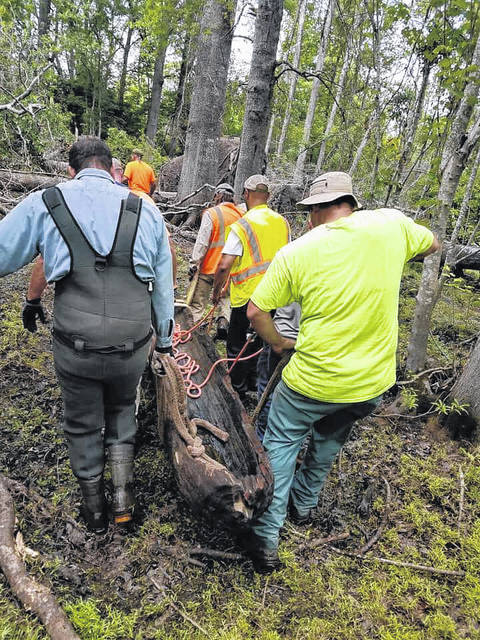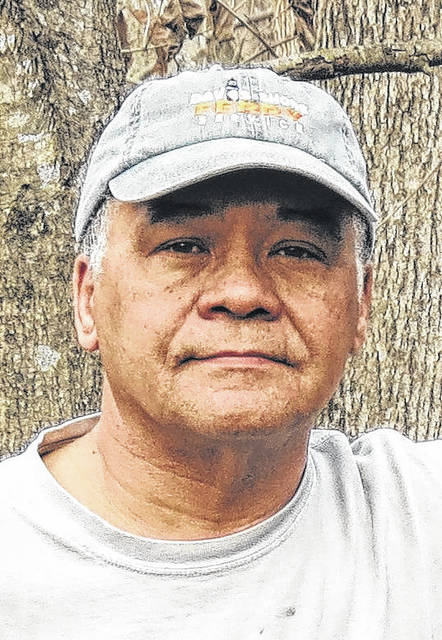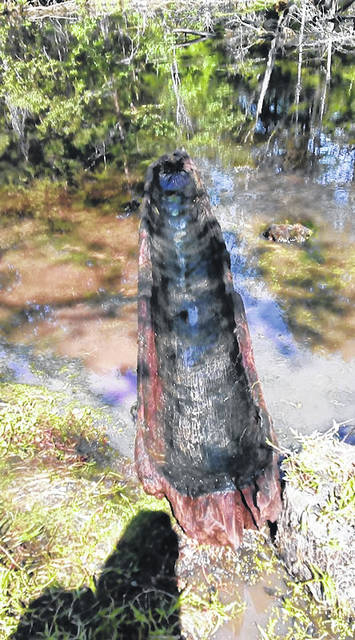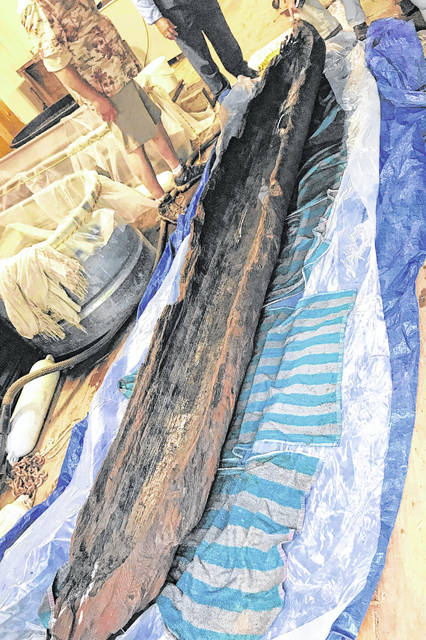A move is afoot to get a pristine piece of Sampson County’s rich history back where it belongs.
On May 13, Autryville resident Jonathan Autry discovered a burned-out canoe in South River, reportedly near the old train trestle crossing west of old Highway 24 in Autryville. Representatives with Friends of Sampson County Waterways (FSCW) were notified days later and asked about the find, a relic from times past.
FSCW vice president Philip Bell, a member of the Coharie Tribe, said that reports suggest staff from Cumberland County Parks and Recreation and the Transportation Museum removed the canoe from the Sampson County side of the bridge and transported the canoe to Fayetteville. Bell said an artifact found in rivers belongs to the state.
The canoe, measuring 12 feet long, 20 inches wide, and close to a foot deep, ultimately found its way to Fort Fisher.
“We were contacted at the Coharie Indian Center on May 17 by the state archaeologist who asked us what we knew about the canoe, and we had no idea what he was talking about,” said Bell. “When we got over there, we found out that Parks and Recreation with Cumberland County, along with the Transportation Museum director … seized the canoe.”
The canoe is currently undergoing preservation treatment at the Underwater Archaeology Lab in Fort Fisher. Bell said the canoe is about 18 months away from being curated, and said it was his hope Sampson County officials would support the canoe’s return to this county, whether that is at the tribal center or the Sampson County History Museum.
Preliminary observations suggest it is a Native American artifact, possible predating European colonization of the area, Bell noted. He said many within the Coharie Tribe are interested in ensuring the canoe is returned to Sampson County, home of the Coharie, one of seven recognized by the State of North Carolina.
“Custody and display of the canoe is paramount in the eyes and hearts of the Coharie people,” Bell stated. “This canoe represents another relic of the past validating existence of Native American residents who, following colonization, immigration and encumbered trials, have weathered the test of time. This canoe is important to sharing the story of the Coharie people’s past, culture and resilience. Possession of a prestigious historical object like this canoe that points back to one’s heritage is a significant find for elders of the tribe and a great teaching tool for generations to come.”
Growing up along U.S. 421, Bell said digging up little bits of history here and there was nothing out of the norm, but this is a big find.
“We’ve found artifacts for years, but never anything like this,” said Bell. “This is a fine tourist attraction that people will really want to look at,” said Bell. “This is something that could really showcase.”
The Sampson County Board of Commissioners recently threw their formal support behind the Friends of Waterways’ efforts and their desire to return a treasured artifact to its home county.
“We support these efforts as the canoe represents an important part of Sampson County’s history and can serve as an integral part of our efforts to promote our heritage and educate our citizens and visitors alike,” a letter from board chairman Clark Wooten and board members stated.
FSCW president Don Meece said the rivers themselves serve as a tourist attraction every year. Taking care of that precious natural resource is vital — and adding a historical element could only help bring people to Sampson.
A nonprofit group, FSCW attempts to protect and keep the county’s 300 miles of waterways clean of trash and clear of trees blocking the natural path. Additionally, the group regularly hosts paddle trips to provide education and pass on appreciation of the county’s river systems.
“One of the major draws to this county are the rivers,” Meece said.
And the effort to take care of them is ongoing.
In 2015, a volunteer assembly of Coharie Indians along the Upper Great Coharie River started the Great Coharie River Initiative, with the goal of creating a navigable corridor along what Bell deemed “an almost forgotten waterway that flows through 4,800 acres of prime educational opportunity, potential tourism attraction and economic stimulus that is being underutilized.”
The Coharie Tribe, in cooperation with the U.S. Department of Agriculture’s Natural Resources Conservation Service and the FSCW, is working together to implement debris removal operations that will open more than 20 miles the Great Coharie River. Uncovering a piece of history and preserving it goes hand in hand with the waterways group’s mission.
“Displaying a pristine conditioned canoe found and retrieved from county waters will attract history buffs from all across the country,” Bell stated. “Educational institutions will be afforded opportunities to observe an interesting part of history and the canoe will add another critical chapter to the Sampson’s rich history. Housing the canoe in the Sampson County History Museum will offer a prize attractant for a broad spectrum of potential visitors.”
Those visitors will be good for the local economy, he stated. Along with supporting the canoe’s preservation and its return to Sampson, county officials lauded Bell, Meece and others for their continuing work to preserve and protect the waterways.
“Given the county’s limited resources,” the board stated in its letter, “your organization’s efforts to increase awareness of our waterways and your fiscal prudence in obtaining grant funding for these efforts is particularly commendable.“




